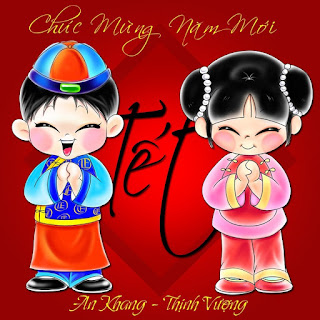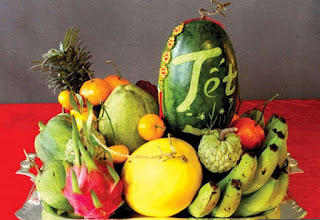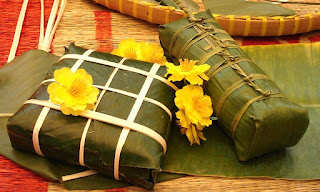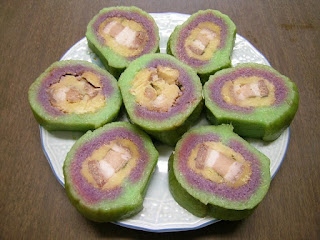Tet has become so familiar, so sacred to the Vietnamese that when Spring arrives, the Vietnamese, wherever they may be, are all thrilled and excited with the expect of Tet holiday, and they feel an immense nostalgia, wishing to come back to their homeland for a family reunion and a taste of the particular flavours of the Vietnamese festivities. Tet starts on the first day of the first lunar month and is the first season of the new year (according to the lunar calendar), and therefore it is also known as the Tet Nguyen Dan, literally meaning Fete of the First Day, or the Tet Tam Nguyen, literally meaning Fete of the Three Firsts.
The Vietnamese, wherever they may be, are all thrilled and excited with the advent of Tet, and they feel an immense nostalgia, wishing to come back to their homeland for a family reunion and a taste of the particular flavours of the Vietnamese festivities. (Vietnamese people, where ever they are, in their home land or oversea the Tet cerlebration alway celebrate in traditional way) Those who have settled down abroad all turn their thoughts to their home country and try to celebrate the festivities in the same traditional way as their family members and relatives to relieve their nostalgia, never forgetting the fine custom handed down from generation to generation.
TET Holiday
The Tet of the New Year is, above all, a fete of the family. This is an opportunity for the household genies to meet, those who have helped during the year, namely the Craft Creator, the Land Genie and the Kitchen God. As the legend goes, each year on December 23 of the lunar calendar, the Kitchen God takes a ride on a carp to the Heavenly Palace to make a report on the affairs of the household on earth and then returns on December 30 to welcome the New Spring.
Tet is also an opportunity to welcome deceased ancestors back for a family reunion with their descendants. Finally, Tet is a good opportunity for family members to meet (Tet also is a chance for family reunion). This custom has become sacred and secular and, therefore, no matter where they are or whatever(they go, all menber try to come back their home to meet other.) the circumstances, family members find ways to come back to meet their loved ones
Cay Neu
Vietnamese Tet has quite a few original practices with customs and entertainment that have distinct Vietnamese cultural characteristics. In the framework of this article, a few customs and practices are presented so that readers can better understand the traditional Tet of Vietnam.
Long long ago, humans and devils co-inhabited the earth. The devils overwhelmed the former and invaded their land. Buddha told the devils: "I will hang my cassock on top of the bamboo, and wherever the shadow falls is Buddha's land, and you devils must give it to men." The devils agreed. So after planting the bamboo, Buddha flung his robe to the top and made the bamboo higher by means of magic; as a result, the cassock overshadowed the whole land and the devils were chased to the East Sea. Then the devils prayed to Buddha for permission to return to the mainland for a three day visit to their ancestors' tombs on the occasion of Tet. For this reason, Neu is often planted on this occasion. It is a bamboo pole with green leaves, an eight sign amulet and earthen bells hung from its top. Lime powder is scattered round its base to allow the painting of cross-bows and arrows to chase away the devils or keep them at bay.
The "Mam Ngu Qua"
The "five-fruit tray" on the ancestral altar during the Tet Holidays symbolizes the admiration and gratitude of the Vietnamese to Heaven and Earth and their ancestors, and demonstrates their aspiration for a life of plenty. As one theory goes, the five fruits are symbolic of the five basic elements of oriental philosophy: metal,wood, water, fire, and earth. Some people believe that the five fruits are symbols of the five fingers of a man's hand that is used to produce physical wealth for his own use and to make offerings to his ancestors. However, in a simpler way, the five fruits represent the quintessence that Heaven and Earth bless humans. This is one of the general perceptions of life of the Vietnamese, which is "When taking fruit, you should think of the grower". Today, the tray may contain five or more fruits, in the form of a pyramid like before or in an different shape. Regardless, it is still called the Mam Ngu Qua, the five-fruit tray.
Dao, Mai, Quat (the Peach, Apricot and Kumquat)
 Coming to Vietnam during the season of the Tet festival, the visitor is engulfed in an ocean of colourful flowers. Visiting flower shows, contemplating the buds and blooms, and purchasing blossoms represents one of the special Vietnamese cultural characteristics. Poor or rich, the northern people cannot go without a twig of peach blossom in their homes, while the southerners, a small branch of apricot blossom, together with a pot of Kumquat. The peach and the apricot blossoms are symbols of the Vietnamese Tet. The warm pink of the peach could very well suitable the dry cold of the North, but the hot South seems to be flourishing(increasing) in the riot of the yellow of the apricot. The mandarin is symbolic of good fortune and, therefore, people offer to choose the little plants laden with fruit, big and orange, and verdant leaves for a longer display.
Coming to Vietnam during the season of the Tet festival, the visitor is engulfed in an ocean of colourful flowers. Visiting flower shows, contemplating the buds and blooms, and purchasing blossoms represents one of the special Vietnamese cultural characteristics. Poor or rich, the northern people cannot go without a twig of peach blossom in their homes, while the southerners, a small branch of apricot blossom, together with a pot of Kumquat. The peach and the apricot blossoms are symbols of the Vietnamese Tet. The warm pink of the peach could very well suitable the dry cold of the North, but the hot South seems to be flourishing(increasing) in the riot of the yellow of the apricot. The mandarin is symbolic of good fortune and, therefore, people offer to choose the little plants laden with fruit, big and orange, and verdant leaves for a longer display.
Composing, challenging and displaying parallels represents an elegant cultural activity of the Vietnamese. On the occasion of Tet, parallels are written on red paper and hung on both sides of the gate, the pillars or the ancestral altar. Each pair of parallels has an equal number of words with contrasting or corresponding meanings and lines of verses. They show a keen intelligence, perception of nature and social life, uphold morality and a yearning for the well-being of all people. The red is symbolic of auspicious and powerful vitality, according to popular belief. Mingling with the green of the banh chung, the pink of the peach blooms, the yellow of the apricot blossoms, and the red of the parallels is sure to make the Spring warmer and cozier.
The "Giao Thua" (New Year's Eve)
The Giao Thua is the most sacred point of time, the passage from the old to the new year. It is popularly believed that in Heaven there are twelve Highnesses in charge of monitoring and controlling the affairs on earth, each of them taking charge of one year. The giao thua is the moment of seeing off the old chieftain upon the conclusion of his term and welcoming in the new one upon his assumption of office. For this reason, every home makes offerings in the open air to pray for a good new year.
After the giao thua is the start of the new year with many customs and practices, amusements and entertainment, all of a distinct Vietnamese folk culture.(If you have time to joy Viet nam Tet holiday to gether with vietnamese people,you have a chance to experience many special and tranditional culture that is impressible idetity)If you have an opportunity to visit Vietnam during the Tet Holidays and to welcome the Tet Festivities, together with the Vietnamese people, you will surely be profoundly impressed by the distinct traditional culture that is rich in national identity.
During the first three or four days of Tet, the first houseguest to offer Tet greetings is considered the "first visitor of the year" (xong dat). Their luck is considered to have a strong effect on the homeowner's business success for the upcoming year. The belief of xong dat remains very strong nowadays, especially among business people.
The "Banh Chung"
As the legend goes, the Banh Chung came into being under King Hung, the national founder, 3,000 4,000 years ago. Prince Lang Lieu, one of the poorest sons of King Hung, made round and square cakes: the round Banh Day symbolizing the sky, and the square Banh Chung symbolic of the earth (under the ancient Viet's perception) and offered them to his Father on the occasion of Spring, and ever since the Banh Chung has been a "must" during the Tet holidays. The Banh Chung is very nutritious, has an original tasty flavour and may be kept for a long time ( because all day cooked). All of its ingredients and materials, from the green wrapping leaves to sticky rice and pork, green peas and pepper inside, are all medicines (according to Oriental Medicine) that act to keep harmony between the positive and the negative, thus helping the blood circulate well and preventing diseases. Certainly, no other cakes could be of such cultural significance and produce such medical effects as the green Banh Chung of Vietnam.
Food Specialties For Tet holiday
Like many other people in the world, the Vietnamese people attach special attention to the celebration of Tet (lunar new year holidays). To prepare for this event, beside reconfiguring the interior of their homes to make them look more beautiful, they pay great attention to the preparation of food specialties, so that they can have delicious and flavourfuI meals for their visitors on the occasion of the new year.In the Vietnamese language, there is a special expression An Tet which literally means "eat the Tet", but which embraces the meaning of celebrating the event with all traditional activities involved, including eating. Eating is important on the new year holidays.On the last day of the old year, the preparation of food to offer to the ancestors is of special significance. Dishes to offer to the ancestors differ in the Northern, Central and Southern parts of the country, depending on their respective weather conditions at the time and on different local agricultural products available. What is common in all regions of the country during Tet holidays are the varieties of soups, and fried, boiled, and stewed dishes. In the North, the menu for the Tet banquet includes pig trotters stewed with dried bamboo shoots, boiled chicken, carp cooked in salted sauce, jellied meat, and kohlrabi, cauliflower or onion fried with pig skin or lean pork. Thus, the menu includes meat, fish and vegetables. In addition, there are two other items that can not be missed: Banh chung (square cake made of glutinous rice, pork and green beans wrapped in the dong leaves and boiled) and pickled onions. As one eats much meat during Tet, one should eat some sour pickled onions to facilitate digestion.In Hue, the ancient imperial city, located in the Central part of the country, the culinary art reached its best in feudal times with hundreds of dishes created for the occasion of Tet for the kings and the royal family. Now during Tet holiday, every family in Hue has Banh tet (round shaped glutinous rice cake), sugarcoated coconut, roasted melon seeds, and different pork dishes. The menu may also include beef cooked with garlic and garligale, various kinds of meat pies such as gio thu (pig's head meat pies), cha lua (pork bologna), grilled shrimp pies, boned pig's trotter stuffed with meat, nem chua (fermented pork hash), pickled scallion, unripe banana cooked in sweet and sour sauce. Preserved fruits are also masterpieces of Hue women. Women here make all kinds of preserved fruit such as ginger, waxy pumpkin, apple, orange, lemon and carrot in various shapes and colours. To welcome Tet is to welcome the spring. However, in January, which is spring time, the weather is still cold. It is a good idea to warm up with a cup of hot tea and a slice of preserved ginger.
Tet Vietnam
In Hue, ginger is grown on the hills. A ginger root from Hue is not as big as the ones grown in Hanoi, but it has a golden yellow colour and a special flavour. In the South, with Ho Chi Minh City as the centre, every family has a pot of pork cooked in coconut milk with salt. As the coconut tree is very popular in his region, the Southerners are accustomed to making use of its milk or its oil when they prepare food, which gives cooked food a special flavour. Pork cooked in coconut milk should have all the skin, fat and lean sections. When done, the fat section looks transparent and the lean one turns reddish with the flavour of coconut milk. Also, there are pickled green bean sprouts with leeks, sliced carrot and turnip. When you eat pickled bean sprouts with pork cooked in coconut milk, you will enjoy it and never get sick of it. As it is warmer in the South than in the North and the Central region, cooked meat is more popular in the North as it stays unspoiled for a longer time. Another favourite for many people is bitter melon stuffed with meat. It is believed by many older people that bitter melon is antipyretic, nutritious and may treat many diseases. Banh tet and banh trang (rice waffle) are a must on the Tet menu. Vegetables, boiled or cooked meat and pickled bean sprouts wrapped in a thin banh trang make a good dish in hot weather. Banh tet usually goes well with dried turnips soaked in fish sauce.The foods that the Vietnamese eat at Tet are varied and diverse What they have in common is that the people throughout the country all want to have the best and the most beautiful looking food on this occasion to offer their ancestors and to treat their friends and guests.
Photo by collect on the internet.








